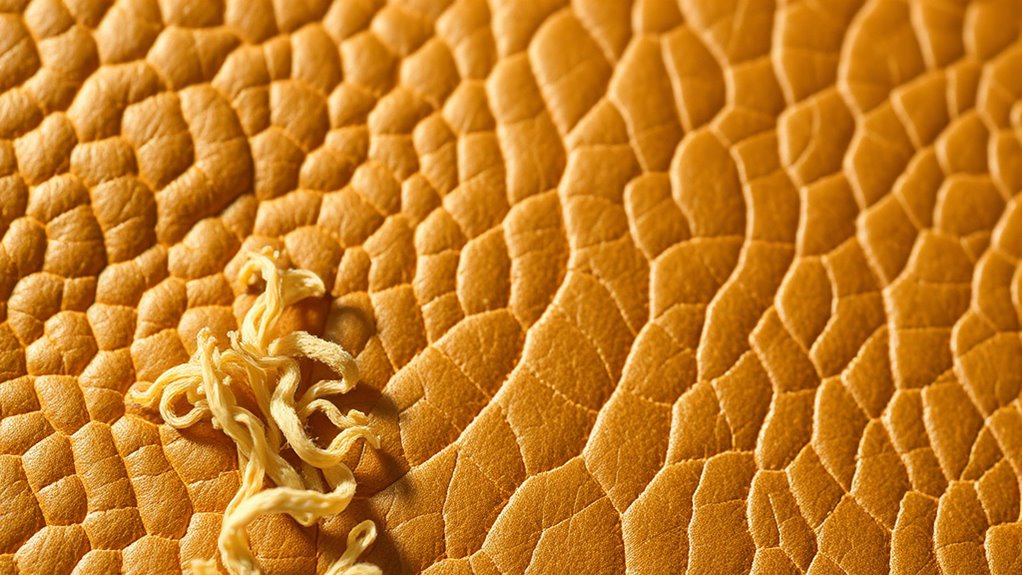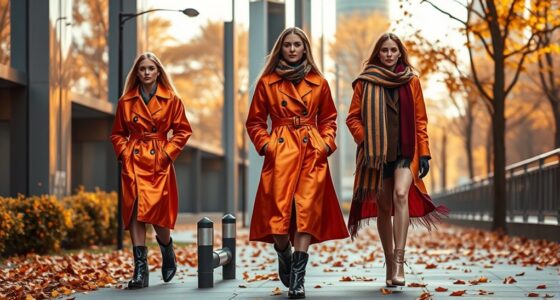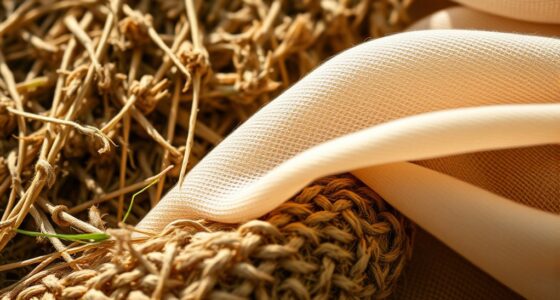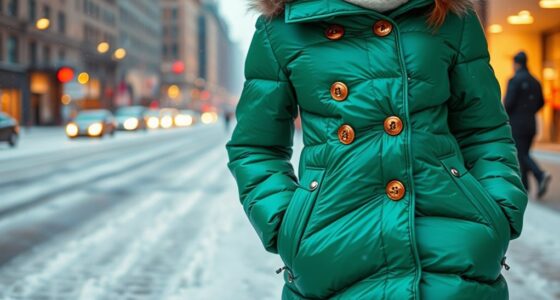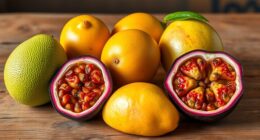Plant-based leather innovations like mushroom and apple leather offer eco-friendly alternatives that reduce environmental impact. Mushroom leather, made from fungi, grows quickly with less water and land, cutting down carbon emissions and supporting sustainability. Apple leather uses food waste, turning peels and cores into versatile, stylish materials that require fewer toxic chemicals. By choosing these options, you support responsible production and a greener future. Keep exploring to discover how these innovations are shaping the future of sustainable fashion.
Key Takeaways
- Mushroom leather is produced from fungi, offering a sustainable alternative with lower water, land use, and carbon footprint.
- Apple leather is made from food waste like peels and cores, reducing waste and avoiding toxic chemicals in production.
- Both materials support eco-conscious fashion by minimizing environmental impact compared to traditional animal leather.
- They provide durable, aesthetically appealing options suitable for various fashion applications.
- These innovations promote responsible sourcing and circular economy practices in the sustainable fashion industry.
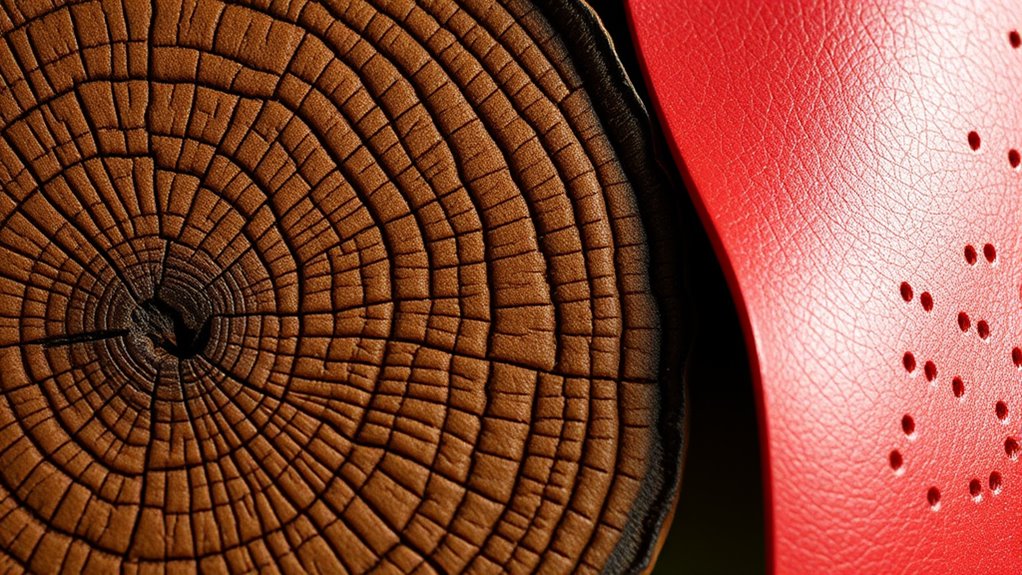
As consumers become increasingly eco-conscious, plant-based leather innovations are transforming the fashion industry. You’re now part of a movement that values sustainable sourcing, which means choosing materials that are produced with minimal harm to the environment. Mushroom and apple leather exemplify this shift, offering alternatives that reduce the environmental impact traditionally associated with animal leather. These materials are made from renewable resources, often utilizing waste products from food industries, which helps minimize waste and lowers the demand for resource-intensive livestock farming.
When you opt for mushroom leather, you’re supporting a process that leverages fungi to create durable, leather-like materials. Mushrooms grow quickly and require far less water, land, and feed compared to raising cattle. This appreciably cuts down on the environmental impact, especially when you consider the carbon footprint associated with traditional leather production. Mushroom leather is cultivated in controlled environments, reducing the risks of deforestation and habitat destruction, common concerns with animal agriculture. The sustainable sourcing of mushroom leather also means it’s less dependent on fossil fuels and chemicals, making it a greener choice overall. Additionally, the versatility of mushroom leather allows it to be used in various fashion applications, expanding sustainable options for designers and consumers alike.
Apple leather is another innovative solution that emphasizes sustainability. It’s made from apple peels and cores, which are typically discarded as waste in the fruit industry. By transforming what would be trash into a high-quality, versatile material, manufacturers reduce waste and lessen environmental degradation. Apple leather’s production process is designed to be eco-friendly, often utilizing fewer toxic chemicals than conventional leather tanning methods. Plus, sourcing apples for leather doesn’t involve deforestation or water-intensive farming, further lowering its environmental impact. When you choose apple leather, you’re supporting a circular economy where waste is repurposed, and resources are used efficiently.
Both mushroom and apple leather demonstrate how sustainable sourcing practices can help reduce the negative environmental impact of fashion. These plant-based options are not only more eco-friendly but also offer comparable durability and aesthetic appeal to traditional leather. By choosing these innovative materials, you’re actively participating in a shift toward more responsible consumption—one that prioritizes ecological balance and reduces harm to natural ecosystems. As the industry continues to evolve, these plant-based leathers are paving the way for a more sustainable future, proving that fashion can be both stylish and environmentally conscious. Incorporating natural materials like these into your wardrobe supports ongoing efforts to create environmentally responsible fashion choices. Your choices matter, and selecting mushroom or apple leather helps support a more sustainable, responsible approach to fashion that aligns with your values.
Frequently Asked Questions
How Do Mushroom and Apple Leather Compare in Durability?
You’ll find that mushroom leather generally offers better durability, as it undergoes rigorous durability testing and has strong wear resistance. Apple leather, while eco-friendly and soft, tends to be less resistant to wear over time. If you’re prioritizing longevity, mushroom leather is a smarter choice because it withstands daily use better. However, both materials are improving, so consider your specific needs and testing results before deciding.
What Are the Environmental Benefits of Mushroom and Apple Leather?
You’ll find that mushroom and apple leather offer significant environmental benefits. They’re made from sustainable farming practices, which reduce the need for resource-intensive materials. Plus, they help preserve biodiversity by utilizing agricultural byproducts and fungi that might otherwise go to waste. Choosing these materials decreases reliance on traditional leather, lowering environmental impact, and promotes eco-friendly innovation. Overall, they support a more sustainable and biodiversity-conscious fashion industry.
Are Mushroom and Apple Leathers Cost-Effective Alternatives?
While mushroom and apple leathers might seem like charming options, their cost comparison to traditional leather varies. You may find that production costs are still rising as industries refine methods, making them somewhat less affordable now. However, as technology advances and economies of scale improve, these eco-friendly alternatives could become more cost-effective, allowing you to enjoy sustainable fashion without stretching your budget too much.
How Do These Materials Handle Moisture and Water Exposure?
You’ll find that mushroom and apple leathers generally have moderate water resistance, but they’re not fully waterproof. They tend to absorb moisture easily, leading to potential damage or mold if exposed to prolonged water or high humidity. To protect these materials, it’s best to apply a water-repellent coating and avoid heavy water exposure. Proper care helps maintain their durability and appearance, ensuring they last longer despite moisture challenges.
Can Mushroom and Apple Leather Be Recycled or Composted?
Think of mushroom and apple leather as delicate seeds awaiting their next life. You can recycle these materials through appropriate recycling processes, though it’s not always straightforward. Composting feasibility depends on their composition; some components break down naturally, while others may need specialized facilities. So, while they offer eco-friendly options, you’ll want to verify local programs to guarantee proper disposal, helping these innovative leathers contribute to a circular, sustainable cycle.
Conclusion
As you explore plant-based leather innovations like mushroom and apple leather, you’ll see how these materials are transforming fashion, much like a fresh breeze reshapes a stale room. They offer sustainable, cruelty-free alternatives that are both stylish and eco-friendly. Embracing these innovations is like planting seeds for a greener future, where creativity and sustainability walk hand in hand. By choosing these options, you help nurture a world where fashion doesn’t cost the Earth.
